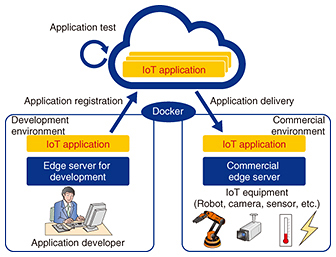 |
|||||||||||||||||||||
|
|
|||||||||||||||||||||
|
Feature Articles: The Internet of Things and New Value Creation Vol. 15, No. 9, pp. 19–25, Sept. 2017. https://doi.org/10.53829/ntr201709fa4 Data Exchange Technology Providing Real-time Data Processing and ScalabilityAbstractThe pervasive spread of the Internet of Things, or IoT, in recent years is remarkable, and NTT is working to incorporate IoT in industries showing the greatest promise for creating new value—manufacturing, the auto industry, agriculture, and other sectors. This article provides an overview of NTT’s initiatives in IoT data exchange technology and edge computing technology, and reviews standardization trends pertaining to these technologies. Keywords: IoT data exchange, edge computing, container-based virtualization 1. Data exchange technology: opening the way to real-time data processing and greater scalabilityThe pervasive spread of the Internet of Things (IoT) in recent years has been truly remarkable, and NTT is working to incorporate IoT in industries showing the greatest potential for creating new value—manufacturing, the auto industry (automatic driving support), agriculture, and other sectors. IoT really comes together in the form of services that connect sensors that gather data, and applications that leverage the gathered data. This involves a vast number and range of devices, and an equally diverse variety of applications. The true value that IoT creates is derived from leveraging new combinations of data gathered by sensors, and today we see growing demand from both the public and private sectors for an IoT data exchange society that supports leveraging and delivery of IoT data across services. This requires IoT data exchange technology that acquires IoT data from a wide variety of devices, then precisely scales the data for delivery to a wide range of applications. However, the ability of certain manufacturing sectors to exploit the IoT has lagged behind as a result of growing network loads, processing speed delays, and the inability to meet the exacting requirements of robotic real-time control, self-driving support in vehicles, and other stringent requirements. NTT is now working to address this challenge by applying edge computing technology to IoT. Edge computing optimizes cloud computing systems by locating computer resources at the edges of the network and thus carrying out data processing near the source of the data. It is apparent that in order to leverage the limited computer resources deployed at the edge of the network, technology for dynamically configuring a software component at the edge of the network is also critically important. This article provides an overview of NTT’s recent work in IoT data exchange technology and edge computing technology and also reviews standardization trends pertaining to these technologies. 2. IoT data exchange technologyIn this section, we explain aspects of IoT data exchange technology, focusing on current trends, research and development (R&D), and standardization. 2.1 Technology trends and R&DUntil now, most schemes for gathering IoT related data have been implemented as standalone systems, so IoT data collected from devices are confined to a single system based on a vertically integrated IoT architecture. However, today we are shifting away from this model with rapidly growing demand for IoT systems based on a horizontally integrated IoT architecture built around a software infrastructure that is not dependent on vendor-specific applications and devices, that provides shared capabilities, and that supports a range of different IoT services and mutual distribution and utilization of IoT data. Horizontal integration has a number of significant advantages over vertical integration [1, 2]: (1) Sharply reduced system development costs made possible by using shared functions and capabilities on the platform (2) Support for a far greater range of connections made possible by abstracting connections between IoT devices and applications (3) More efficient utilization of gathered data among many services In order to create a robust data exchange society capable of creating value by incorporating IoT across diverse industrial sectors and sharing IoT data, we must first build a viable platform—an IoT data exchange platform—that mediates the exchange of IoT data between applications and devices, and NTT is making solid progress in establishing the core IoT data exchange technologies to achieve this objective. We have already compiled considerable knowledge by studying IoT system use cases for particular industries, which has enabled us to define the requirements of the IoT data exchange platform and come up with a platform design that meets these requirements (Fig. 1). NTT has now moved on to the development phase and plans to unveil a practical IoT data exchange platform in the near future.
2.2 Associated standardization trendsIn order to actually implement a horizontally integrated IoT data exchange platform, it would be preferable to base the interfaces between the platform and applications, and between the platform and devices, on an international standard and not simply use an in-house proprietary solution. One promising standard initiative that would meet these requirements is oneM2MTM*1 [3]. To prevent the proliferation of excessive standards, oneM2M was launched in July 2012 as a global organization involving the world’s preeminent standards development organizations*2 that collaborated to develop the requirements and specifications for machine-to-machine (M2M) and IoT technologies. The ultimate goal of oneM2M is to draft standards for a horizontal platform architecture that can be shared by many different industries and services; oneM2M currently has more than 200 participating partners and members, including NTT. Release 1 of the oneM2M standard was issued in February 2015, followed by Release 2 in August 2016, and many companies and organizations have already implemented IoT data exchange platforms in compliance with the standard. One key aspect of oneM2M is interoperability and compliance with other relevant standards—OMA (Open Mobile Alliance), 3GPP (Third Generation Partnership Project), and so on—and considerable work has been done to verify and test the consistency and interconnectivity of oneM2M with other standards. While collaborating with other organizations on standards initiatives, NTT is convinced that oneM2M will be critically important in the deployment of IoT data exchange and is moving boldly to implement an IoT data exchange platform based on the oneM2M standard. 3. Edge computing technologyAnother important area of focus is edge computing technology. We describe key aspects of this technology in this section. 3.1 Technology trends and R&DNTT is breaking fresh R&D ground in pursuit of edge computing that drastically shrinks communication delay from users by deploying edge servers that provide computational resources at the edge of the network in close proximity to user terminals and IoT devices [4, 5]. Offloading the terminal-side processing to the edge server opens the way to markedly enhanced performance: large-capacity application processing at very high throughput unconstrained by computational performance of the terminal. Edge computing is also well adapted for applications requiring real-time response or big data processing that involves frequent communication or large-volume communication with the server. A side-by-side comparison of cloud computing and edge computing is shown in Fig. 2. Cloud computing provides access to shared computer processing resources on the Internet, and the typical round-trip delay time (RTD) between terminals is less than 100 ms domestically, 100 ms between Japan and the United States, and 200 ms between Japan and Europe.
In the case of edge computing, multiple edge servers are deployed on the periphery of a carrier’s access network. The edge server can be regarded as a small-scale cloud datacenter in close proximity to the user that has arithmetic processing functions and storage capabilities, and that can run application programs and store data content. The user terminal communicates directly with an edge server, and the RTD can be slashed to just a few milliseconds. Moreover, when an edge server is used to perform regional processing, the computational and communication resources used can be localized. For example, by tallying a large number of sensor readings on an edge server instead of delivering the readings one at a time to a central server (in the cloud), and by sending just the key statistical parameters (such as averages and deviations) and noteworthy outliers, the overwhelming bulk of communication can be localized just between the sensors and the edge server, and traffic on the network backbone can be drastically reduced. 3.2 Container-based virtualization edge server architectureEdge servers for IoT might be implemented in a number of different ways, but at NTT, we assume rather tight constraints on the server’s computer resources (the CPU (central processing unit), memory, and disk I/O (input and output)), so our efforts have focused on a container-based virtualization edge server architecture. Container-based virtualization is an operating system-level virtualization method for running multiple isolated resource systems called containers on a computer. Compared to the older hypervisor-based virtualization method, container-based virtualization uses far fewer resources for processing and also ensures application portability between different equipment. A schematic overview of hypervisor- versus container-based virtualization is shown in Fig. 3.
Adopting this type of containerized virtualization while incorporating an IoT data exchange platform and various applications onto an edge server would enable us to tailor the amount of computer resources for each process according to priority, which would significantly upgrade resource utilization efficiency. A schematic of how this would work is illustrated in Fig. 4.
Another well-known platform for container-based virtualization is the open-source container management software Docker [6]. We are currently evaluating this software for distributing and managing containerized applications. Docker is able to deliver and exercise executive control over applications based on containerized virtualization. Therefore, by adapting Docker to connect edge servers in development and commercial environments, one can build an environment that seamlessly covers the entire sequence from application development and testing to distribution and monitoring (Fig. 5). This strategy will contribute to the rapid uptake of IoT by creating an environment that promotes rapid development of applications and proliferation of edge servers by application service providers, equipment vendors, users, and other players.
3.3 Associated standardization trendsEdge computing has attracted a great deal of interest as a promising new approach for opening the way to application areas that are currently not covered by conventional cloud computing, and much standardization work has already been completed. The Industry Specification Group (ISG) of ETSI (European Telecommunication Standards Institute) has been especially active since 2014 in pursuing work on MEC (which initially stood for Mobile Edge Computing, but was later changed to Multi-access Edge Computing) [7]. NTT and NTT DOCOMO have been involved in work on MEC since ISG was first organized. We have carefully considered technical requirements of edge servers for a variety of different use cases and have drawn up function-level architectures and basic API (application programming interface) specifications. In a related development, the Open Edge Computing Initiative organized by Carnegie Mellon University has set up a city-scale testbed that consists of a number of edge servers and wireless base stations to conduct field trials of this architecture [8]. 4. Future developmentA good portion of the technology described in this article is now being applied as a first use case in manufacturing and is now being incorporated in the IoT platform FIELD system*3 [9] for manufacturing, which is under development by FANUC CORPORATION, an industry leader in robotics. Building on work done so far, we will of course further consider these technologies as manufacturing use cases, but at the same time will continue to pursue R&D on IoT data exchange technology and edge computing technology with the goal of applying this work to other sectors and opening a new era of the IoT data exchange society.
References
|
|||||||||||||||||||||


















